The ideal temperature range for a bearded dragon depends on its age. Here are the recommended temperature ranges for the different growth stages of a bearded dragon:
- Baby Beardies (0-5 Months Old):
- Enclosure temperature: 80°F to 85°F
- Basking area temperature: 95°F to 110°F
- Cooling zone: 80-90°F
- Juvenile Beardies (6-18 Months Old):
- Basking area temperature: 95°F to 100°F
- Room temperature: 80°F-90°F
- Adult Beardies (Over 18 Months Old):
- Blaying area temperature: 90°F-93°F
- A cool area: 80°F-90°F
The bearded dragon cannot survive in temperatures below 75°F and may suffer from health conditions such as metabolic bone disease if they are kept in temperatures below this temperature.
It is important to ensure that your bearded dragon does not fall below 65°F for more than 24 hours, since anything below that level may result in health problems and even death.
The importance of temperature for bearded dragons’ well-being
Bearded dragons, also known as Pogona vitticeps, are fascinating reptiles that require specific environmental conditions to thrive. One crucial aspect of their care is maintaining the appropriate temperature range.
The temperature plays a vital role in their overall well-being, affecting their metabolism, digestion, immune system, and behavior.
The ideal temperature range for bearded dragons
To ensure the optimal health of a bearded dragon, it is essential to provide them with a suitable temperature gradient within their enclosure. The ideal temperature range for bearded dragons varies throughout the day, as they require a warm basking spot and a cooler area for thermoregulation.
During the day, the basking area should be approximately 95-105 degrees Fahrenheit (35-40 degrees Celsius), allowing them to digest food properly and absorb essential nutrients. The cooler side of the enclosure should range between 75-85 degrees Fahrenheit (24-29 degrees Celsius) to provide a comfortable resting space.
The risks of extreme temperatures for bearded dragons
Extreme temperatures can pose significant risks to the health and well-being of bearded dragons. Both excessively high and low temperatures can lead to severe consequences, including heat stress, dehydration, organ failure, and even death.
Understanding the effects of low temperatures on bearded dragons
Bearded dragons are ectothermic creatures, meaning that they rely on external heat sources to regulate their body temperature. When subjected to prolonged exposure to low temperatures, they may experience a condition called brumation, which resembles hibernation in mammals.
Brumation is a natural behavior for bearded dragons during the colder months, as it allows them to conserve energy and cope with reduced food availability.
If the temperatures drop too low or they are unable to warm themselves adequately, it can result in health issues. Bearded dragons may become sluggish, lose their appetite, and their immune system may weaken, making them more susceptible to illnesses.
Recognizing the signs of heat stress in bearded dragons
Heat stress is another serious concern for bearded dragons, especially when the ambient temperature exceeds their tolerance limits.
When exposed to excessively high temperatures, bearded dragons may display various signs of distress, such as excessive panting, gaping, glass surfing (repeatedly running along the enclosure walls), decreased appetite, and lethargy.
If not addressed promptly, heat stress can lead to heatstroke, which is a life-threatening condition. The body temperature of a bearded dragon can rapidly rise to dangerous levels, causing neurological damage, dehydration, and eventually death.
The lethal effects of high temperatures on bearded dragons
When the ambient temperature becomes too hot for a bearded dragon, its body’s ability to regulate heat through behaviors like basking and seeking shade becomes insufficient. This can lead to potentially fatal consequences.
If bearded dragons are exposed to temperatures above 110 degrees Fahrenheit (43 degrees Celsius) for an extended period, it can result in severe heatstroke or even organ failure. Heatstroke can cause irreversible damage to internal organs, leading to a rapid decline in health and eventual death if not addressed immediately.
Preventing temperature-related fatalities in bearded dragons
To ensure the well-being and safety of bearded dragons, it is crucial for owners to closely monitor and regulate the temperatures in their enclosures. Here are some essential steps to prevent temperature-related fatalities:
- Invest in a high-quality thermometer and hygrometer to accurately measure the temperatures and humidity levels within the enclosure.
- Provide a properly sized heat lamp or ceramic heat emitter to create a warm basking spot. This will allow your bearded dragon to thermoregulate effectively.
- Use a temperature-controlled thermostat to regulate the temperature of the heat source, preventing overheating or temperature fluctuations.
- Place a thermometer in both the basking area and the cooler side of the enclosure to ensure that the temperatures remain within the appropriate range.
- Regularly monitor the ambient temperature and adjust the heat source accordingly to maintain a consistent and safe environment for your bearded dragon.
- Provide various hiding spots, caves, and materials for your bearded dragon to seek shade and escape from excessive heat if needed.
- Ensure proper ventilation in the enclosure to prevent the buildup of heat and humidity, especially during warmer months.
- Educate yourself on the environmental temperature requirements specific to your bearded dragon’s age and species to provide the most suitable conditions.
The role of heat lamps and thermometers in maintaining an optimal temperature
Heat lamps play a crucial role in maintaining the ideal temperature gradient within a bearded dragon’s enclosure. A well-positioned heat lamp, along with a proper thermometer to monitor temperatures, allows pet owners to create the perfect basking spot and cooler areas.
It is essential to choose heat lamps suitable for reptiles, such as ceramic heat emitters or mercury vapor bulbs. Regularly check the bulbs for any signs of wear and tear, as damaged bulbs can pose risks such as overheating or shattering.
Thermometers are invaluable tools for monitoring temperature fluctuations. Digital thermometers with remote probes or infrared thermometers can accurately measure temperatures within the enclosure, ensuring the well-being of your bearded dragon.
Proper temperature regulation during different seasons
As the seasons change, it is crucial to adjust the temperature within the bearded dragon’s enclosure accordingly. During colder months, when the ambient temperatures in your home may drop, additional heating may be required to maintain the appropriate temperature range.
Using a ceramic heat emitter or a heat mat can provide supplemental warmth during colder periods. Conversely, during warmer months, it is important to monitor the enclosure’s temperature to prevent overheating. Consider using fans or air conditioning to maintain a comfortable environment for your bearded dragon.
Conclusion
In conclusion, understanding and maintaining the appropriate temperature range is vital for the health and well-being of bearded dragons. Extreme temperatures, whether too hot or too cold, can have devastating effects on these reptiles, leading to heat stress, dehydration, organ failure, and even death.

This image is property of beardeddragonsworld.com.
